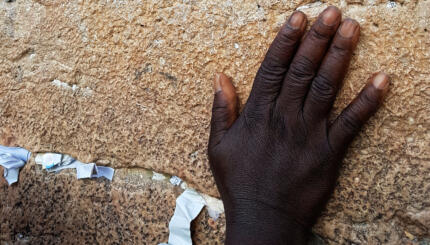Reprinted with permission of author from Four Centuries of Jewish Women’s Spirituality: A Sourcebook (Beacon Press).
Create a tradition? A tradition is based on accumulated experience, handed down from ancestors to posterity. Well, I believe I did just that! I created a ceremony, a rite of passage from adult to elder, to establish my presence in the community as a functional and useful human being. The ritual also served some personal needs: that of facing my mortality, for instance.
 Calling my ritual a tradition may be a misnomer since my ritual has not been “handed down to posterity.” Nevertheless, I felt that a crone ceremony [a ritual to celebrate aging] filled a significant need in our society. Subsequently, others have created similar rites of passage based on my own, and I have been asked to speak and write about this experience on various occasions. I think I can consider that I have “handed down” my experience.
Calling my ritual a tradition may be a misnomer since my ritual has not been “handed down to posterity.” Nevertheless, I felt that a crone ceremony [a ritual to celebrate aging] filled a significant need in our society. Subsequently, others have created similar rites of passage based on my own, and I have been asked to speak and write about this experience on various occasions. I think I can consider that I have “handed down” my experience.
Inspired by Genesis Stories
I decided to have a ritual on the occasion of my 60th birthday. Sixty seemed to me an appropriate age because I had just begun to feel the physical changes that come with age, changes that required a modification of my lifestyle. However, the reason I was drawn to assume my new status with a ceremony was inspired by the Genesis narratives I have been so involved with for the past decade.

Help us keep Jewish knowledge accessible to millions of people around the world.
Your donation to My Jewish Learning fuels endless journeys of Jewish discovery. With your help, My Jewish Learning can continue to provide nonstop opportunities for learning, connection and growth.
I came to realize that the biblical stories that dealt with Sarah, Hagar, and Abraham were, in most cases, rituals. Each time a ritual was performed, the life of the protagonist changed radically. Ostensibly, the main theme dealt with in the Bible is succession: Sarah acquired a son; Hagar acquired a son; and Abraham acquired two sons. But the overall theme is the spiritual journey our ancestors set out on. Both Sarah and Abraham are advanced in age at the time of their calling, so I thought that their summons was a propitious one for us to follow. I therefore included in the ritual elements from the Genesis narratives: a blessing, a change of name, a covenant, a reconciliation with death, an affirmation of life.
Role of Community
A ritual must fulfill a communal need as well as a personal one. That is the reason why I decided to have other women, whom I consider to be a part of my spiritual community, create the ritual with me.
I have been asked on various occasions why I chose to have the ceremony at temple instead of having it at my home. I did this for various reasons: The temple symbolizes community, but, more than that, it symbolizes Jewish community; it represents the substance of my roots; furthermore, I was able to perform the liturgy denied me as an Orthodox Jewish woman.
I included portions of the Sabbath service because I envisioned Simchat Hochmah [literally, a “the joy of wisdom”] to be a truly Jewish ritual that springs from specifically Jewish roots. The highlights of the Sabbath service include carrying the scrolls and reading the weekly portion. Carrying the scrolls and reading from Torah were a deeply moving experience for someone who had been allowed on the bimah [the platform facing the Ark where the scrolls are kept] only on her wedding day. It was as though I had been accepted as a full Jewish person for the first time in my life!
Unlike the terse sentences that report the deaths of the patriarchs, there is an entire chapter in Genesis dedicated to the death and burial of the matriarch Sarah. One of the reasons for this exceptional treatment is because of Sarah’s status as mother of a people, of a life reflected in death; but I think it was also symbolic of the magnitude of mortality in the lifecycle. I believe that the detailed description of Sarah’s death and burial established her position in life, her mortality, and the wisdom of the immortality of her essence. Genesis 23, then, teaches us the internalization of death in the lifecycle.
Wearing White
How to face mortality in one’s own ceremony is a difficult proposition, to say the least. It was feminist scholar Drorah Setel’s inspiration that led me to consider wearing a . The kittel is a white ceremonial robe worn by some congregants on solemn occasions such as and Yom Kippur, during one’s lifetime, and serves in death as the shroud. In this way the body is clothed in the same manner in the sanctity of life as… in the sanctity of death. It is symbolic, in the larger scheme of things, of the cycle of life and death in harmony with the cosmos.
I began the ceremony wearing an ancient robe, woven and made by women of Macedonia, which I had bought some years ago in Yugoslavia. Halfway into the ritual, I changed into a white linen galabie that I had brought with me from Jerusalem, where I had been that summer. The galabie is a simple garment, like a long shirtdress, the customary attire of Middle Eastern men and women. This garment was particularly meaningful to me because my cultural background is Syrian and the galabie was worn by my ancestors.
I think that anyone seriously considering taking part in a Simhat Hochmah ritual should include the experience of wearing a kittel, the garment they will be buried in. It is a sobering occurrence and was, perhaps, the most moving part of the ritual.
Making a Covenant or Promise
Another element from the Sarah and Abraham story that I chose to include in the ritual was a covenant or a promise. A covenant is a solemn commitment that binds two parties to fulfill an agreement in which each is rewarded by the action of the other. A promise is an assurance by one person to fulfill an agreement, perhaps give a reward, but the rewarding is not reciprocal.
God made covenants with Abraham and made promises to Sarah. I elected to make a pledge in memory of the promises made to Sarah. I offered my community a Beth Chayim Chadashim [the name of my synagogue] grant to anyone who would continue my work in feminist Judaism.
I ended the ritual with the planting of a tree. Trees were a significant spiritual symbol for our ancestors: Sarah lived in elonei mamre, a grove of sacred terebinths at Mamre; Deborah, Rebekah’s nurse, was buried under an oak in Beth El; Abraham planted a tamarisk at Beer-sheva, etc.
Trees symbolized the connection between the depths of the earth, where life is quickened, and the canopy above, where life becomes visible. I brought a young tree (in a pot) to temple and symbolically planted it with handfuls of earth and enjoined those who wished to partake in the planting.


